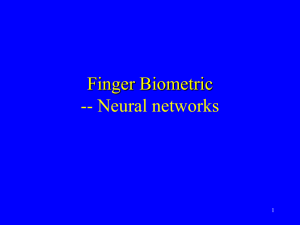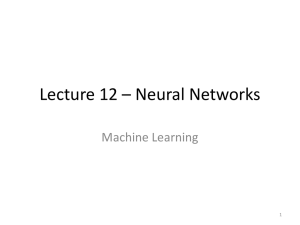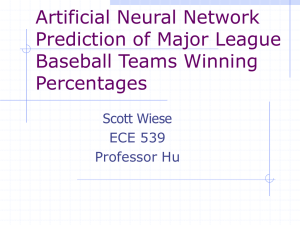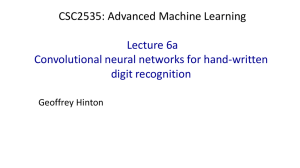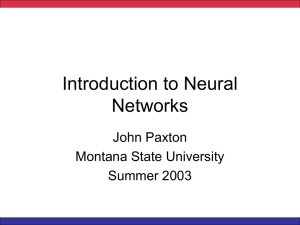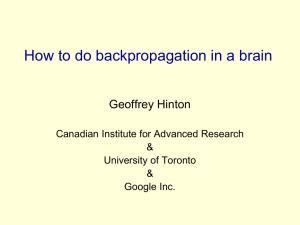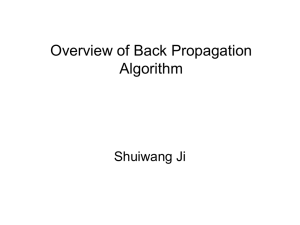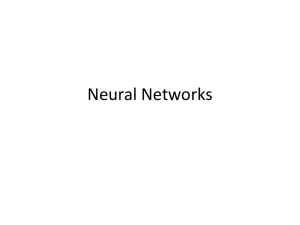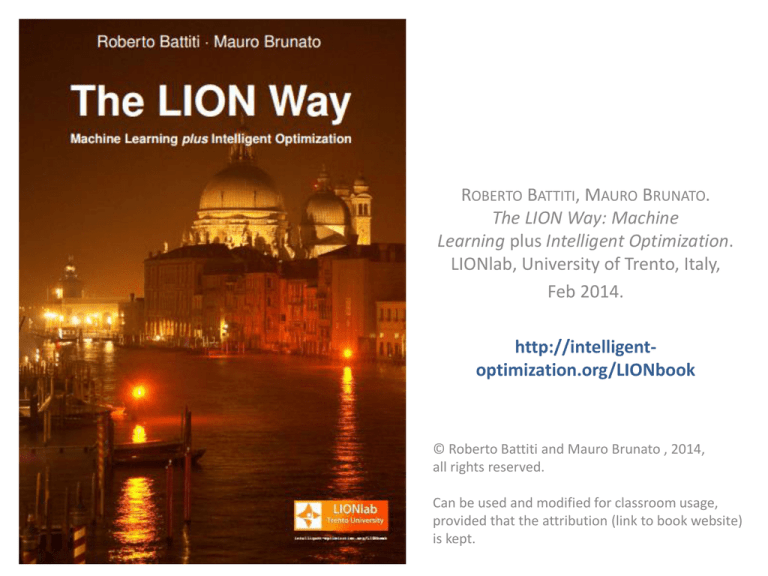
ROBERTO BATTITI, MAURO BRUNATO.
The LION Way: Machine
Learning plus Intelligent Optimization.
LIONlab, University of Trento, Italy,
Feb 2014.
http://intelligentoptimization.org/LIONbook
© Roberto Battiti and Mauro Brunato , 2014,
all rights reserved.
Can be used and modified for classroom usage,
provided that the attribution (link to book website)
is kept.
Chap. 9 Neural networks,
shallow and deep
Quegli che pigliavano per altore altro che la natura, maestra de' maestri,
s'affaticavano invano.
(Leonardo Da Vinci)
The biological metaphor
• Our neural system is composed of 100 billion
computing units (neurons) and 1015
connections (synapses).
• How can a system composed of many simple
interconnected units give rise to highly
complex activities?
• Emergence: complex systems arise out of a
multiplicity of relatively simple interacting
units.
Drawings of cortical lamination by Santiago Ramon y Cajal, each showing a vertical
cross-section, with the surface of the cortex at the top. The different stains show the
cell bodies of neurons and the dendrites and axons of a random subset of neurons.
Symbolic vs. sub-symbolic paradigm
• ”Standard” sequential computers operate in
cycles, fetching items from memory, applying
mathematical operations and writing results back
to memory.
• The intelligence of biological brains is different, it
lies in the interconnection strengths, learning
occurs by modifying connections (dynamical
systems)
• Neural networks do not separate memory and
processing but operate via the flow of signals
through the network connections.
Artificial Neural Networks
• A neuron is modeled as a simple computing unit,
a scalar product w x (“pattern matching”)
followed by a sigmoidal (“logistic”) function.
• The complexity comes from having more
interconnected layers of neurons involved in a
complex action (if linear layers are cascaded, the
system remains linear)
• The ”squashing” functions is essential to
introduce nonlinearities in the system
Multilayer Perceptrons (MLP)
• By applying a sigmoidal transfer function to
the unlimited output of a linear model, one
obtains an output in [0,1] which can be
interpreted as a probability
• For classification, hyperplane boundaries
become “fuzzy”
Multilayer Perceptrons (MLP)(2)
• Composing linear transformations still
linear functions.
• Composing linear functions with nonlinear
sigmoids one can approximate all smooth
functions. One hidden layer is sufficient.
• The first linear transformation provides a first
”hidden layer” of outputs, the second
transformation produces the visible outputs
from the hidden layer.
MLP architecture
• MLPs are composed of a large number of
interconnected units working in parallel and
organized in layers with a feedforward
information flow.
MLP architecture (2)
• The signals flow sequentially from the input to the
output layer.
• For each layer, each unit does the following:
1. scalar product between a vector of weights and the
vector of outputs of the previous layer;
2. nonlinear function to each result to produce the input
for the next layer
• A popular transfer function is the
sigmoidal (or “logistic”) function
MLPs are universal approximators
• What is the flexibility of the MLP architecture to
represent input-output mappings?
• An MLP with one hidden layer and a sufficient
number of hidden nodes can approximate any
smooth function to any desired accuracy.
• MLPs are very flexible models: they can
approximate any smooth input-output
transformation.
Analyzing a neural network output with LIONoso Sweeper. The output
value, the energy consumed to heat a house in winter, is shown as a function of
input parameters. Color coded output (left), surface plot (right). Nonlinearities are
visible.
Error Backpropagation
• How do we learn optimal MLPs from examples?
1. take a ”guiding” function to be optimized (e.g., sumof-squared errors on the training examples)
1. Use gradient descent with respect to the weights to
find the better and better weights
1. Stop the descent when results on a validation set are
best (if over-learning, generalization can worsen).
Learning is not an end, but a means for generalizing.
Backpropagation(2)
• One needs derivatives, a simple analysis exercise.
• MLP is a composition of squash functions and scalar
products.
• Derivatives can be calculated by using the chain rule
for derivatives of composite functions.
• Complexity is O(number of weights).
• Formulas are similar to those used for the forward
pass, but going in contrary direction, hence the term
error backpropagation.
• After the network is trained, calculating the output
from the inputs requires a number of simple
operations proportional to the number of weights.
Batch backpropagation
• Given an MLP, define its sum-of-squareddifferences energy as:
1. Let the initial weights be randomly
Partial derivatives
distributed
2. Calculate the gradient
3. The weights at the next iteration k + 1 are
updated as follows
Bold-Driver Backpropagation
• How do we select the learning rate ε ? If small,
the learning time increases, if big, the energy
oscillates wildly.
1. If successive steps reduce E(w), ε increases
exponentially
2. If E(w) increases, ε decreases rapidly
ρ is close to one (1.1) in order to avoid frequent ”accidents” σ is
chosen to provide a rapid reduction( 0.5), and l is the minimum integer
such that the reduced rate succeeds in diminishing the energy
On-line or stochastic backpropagation
• E is a sum of many terms, one for each pattern p
• The gradient is a sum of the corresponding partial
gradients
• In “batch” gradient descent, first the contributions
are summed, then the small step is taken
• Stochastic BP: randomly choose a pattern p and take
a small step along a single negative
immediately after calculating it.
On-line or stochastic backpropagation (2)
• Stochastic on-line backpropagation update:
• where the pattern p is chosen randomly from
the training set at each iteration and ε is the
learning rate
• Pros: using partial gradients is faster
• Cons: less guarantee of convergence
Advanced optimization for MLP training
• Higher-order derivatives can be used to
enhance the search.
• Conjugate gradient and secant methods
update an approximation of the Hessian by
using only gradient information.
• They are useful for problems with few weights
(approx < 100) and requiring high precision in
the output value.
Deep neural networks
• Some classes of input-output mappings are
easier to build if more hidden layers are
considered.
• The dream: feed examples to an MLP with
many hidden layers and have the MLP
automatically develop internal
representations (encoded in the activation
patterns of the hidden-layers).
Practical obstacles to deep MLPs
• Partial derivatives w.r.t. the weights of the first
layers tend to be very small, leading to numerical
estimation problems.
• As a result, it can happen that the internal
representations developed by the first layers will
not differ too much from being randomly
generated, and leaving only the topmost levels to
do some ”useful” work.
• A very large number of parameters (such as in
deep MLP) can lead to overtraining
Applications of deep learning
Lately, deep learning has lead to superior
classification results in challenging areas
The main scheme is as follows:
1. use unsupervised learning from many
unlabeled examples to prepare the deep
network in an initial state;
2. use back propagation only for the final tuning
with the set of labeled examples
Auto-encoders
• Auto-encoders build internal representations in
an unsupervised manner
• One builds a network with a hidden layer and
demands that the output simply reproduces the
input
• Squeezing: in the hidden layer the input is
compressed into an encoding c(x) with less
variables than the original one
• c(x) will be forced to discover regularities in the
input patterns
Auto-encoders (2)
Auto-encoders (3)
• The auto-encoder can be trained by
backpropagation
• Classification labels are not necessary
• After the auto-encoder is built, the hidden
layer (weights and hidden units) is
transplanted to a second network with an
additional layer, intended for classification
• This new network will be trained on the
labelled examples to realize a classifier.
Auto-encoders (4)
Auto-encoders (5)
• A chain of subsequent hidden layers by iterating
and composing subsequent encodings c’(c(x))
• At each iteration, the
auto-encoder derives
a more compressed
internal
representation
• Appropriate numbers for the number of layers
and the optimal number of units can be obtained
pragmatically by cross-validation.
Advanced training methods
Denoising auto-encoders
• Add to each pattern x a random noise and ask
the auto-encoding network to reconstruct the
original noise-free pattern x.
• This encourages the system to extract even
stronger and more significant regularities from
the input patterns
Advanced training methods(2)
Random dropout
• In stochastic backpropagation training, each
hidden unit is randomly omitted from the
network with probability 0.5.
• Each unit cannot rely on the presence of the
other hidden units and is encouraged to
identify useful information, independently of
the other units.
Advanced training methods(3)
Curriculum learning
Training examples are presented to the network
by starting from the easiest cases and then
gradually proceeding to the more complex ones.
Gist
• Multi-layer perceptron neural networks (MLPs)
are a flexible (non-parametric) modeling
architecture composed of layers of sigmoidal
units interconnected in a feedforward manner
only between adjacent layers.
• Training from labeled examples can occur via
variations of gradient descent (error
backpropagation).
• Although gradient descent is a weak optimization
method, it yields successful practical results.
Gist(2)
• Deep neural networks composed of many
layers are becoming effective
• Learning schemes for deep MLP consist of:
1. an unsupervised preparatory phase
2. a final tuning phase using the scarce labeled
examples.
Gist(3)
• To improve generalization, the use of
controlled amounts of noise during training is
effective
• Increasing the effort during training pays
dividends in terms of improved generalization


